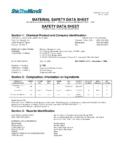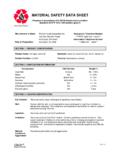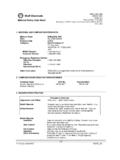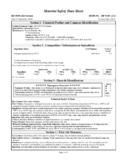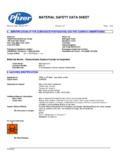Transcription of MATERIAL SAFETY DATA SHEET - FUMIGATION …
1 MATERIAL SAFETY data SHEET . Quickphos FUMIGATION Tablets and Pellets Date of Issue: October 23, 2002. 1. IDENTIFICATION OF THE SUBSTANCE / MIXTURE AND SUPPLIER. Product name: Quickphos FUMIGATION Tablets and Pellets Other names: Phostoxin Product code: 66404. Recommended Fumigant for grain protection and pest control use. use: Supplier: Bayer Environmental Science A Business Group of Bayer CropScience Pty Ltd ABN 87 000 226 022. Address: 391 - 393 Tooronga Road, East Hawthorn Victoria 3123, Australia Telephone: (03) 9248 6888. Facsimile: (03) 9248 6800. Website: Contact: Technical Manager (03) 9248 6888. Emergency Telephone 1800 033 111 Orica SH&E Shared Services Number: 2. HAZARDS IDENTIFICATION. HAZARDOUS SUBSTANCE - DANGEROUS GOOD. Will irritate eyes and skin. Flammable Hazard Hazardous according to criteria of Worksafe Australia designation: Risk phrases: R15 Contact with water liberates highly flammable gases R29 Contact with water liberates toxic gas R28 Very toxic if swallowed R32 Contact with acids liberates toxic gases SAFETY phrases: Not applicable ADG Class classification: SUSDP Schedule 7 (Standard for the Uniform Scheduling of Drugs and classification: Poisons).
2 3. COMPOSITION / INFORMATION ON INGREDIENTS. Ingredients: CAS Number: Concentration (g/kg): Aluminium phosphide [20859-73-8] 570. Ammonium carbamate [1111-78-0] <300 g/kg Inert ingredients - <65 g/kg Page 1 of 8. MATERIAL SAFETY data SHEET . Quickphos FUMIGATION Tablets and Pellets Date of Issue: October 23, 2002. 4. FIRST AID MEASURES. If poisoning occurs, immediately contact a doctor or Poisons Information Centre (telephone 13 11 26), and follow the advice given. Show this MATERIAL SAFETY data SHEET to a doctor. Inhalation: Affected persons should be immediately removed from the contaminated area into the open air and given oxygen treatment. Apply artificial respiration using a respirator if the patient is not breathing. DO not apply mouth to mouth resuscitation. Skin contact: If powder or granules of Quickphos get on skin or clothing brush or shake MATERIAL off clothes in a well ventilated area. Allow clothes to aerate in a well ventilated area prior to laundering. Do not leave contaminated clothing in occupied and/or confined areas.
3 Wash contaminated skin thoroughly with soap and water. Eye contact: If dust from product gets into the eyes flush with plenty of water. Get medical attention. Ingestion: Do not use mouth-to- mouth resuscitation. Place patient in a flat position and allow to rest. Do NOT administer any milk, butter, oils ( castor oil) or alcohol. First Aid Facilities: Provide washing facilities in the workplace. Symptoms: Symptoms of phosphine poisoning include nausea, fatigue, a feeling of oppression in the chest, headaches, and stomach pains. Medical If a patient has swallowed aluminium phosphide (Quickphos). attention: he/she may be emitting toxic phosphine gas. First aid and medical staff should take precautions against exposure to phosphine emitted by such a patient. Do not administer mouth-to-mouth resuscitation - use other forms of resuscitation. 5. FIRE FIGHTING MEASURES. Extinguishing Suffocate flames with sand, carbon dioxide or dry extinguishing media: powder. Do NOT use water on metal phosphide fires.
4 Hazards from Fires involving phosphine or metal phosphides will produce combustion phosphoric acid products: 2PH3 + 4O2 ----> 3H2O + P2O5 ----> 2H3PO4. Precautions for Wear full protective clothing and self-contained breathing fire fighters: apparatus. Contain firefighting water. Page 2 of 8. MATERIAL SAFETY data SHEET . Quickphos FUMIGATION Tablets and Pellets Date of Issue: October 23, 2002. 6. ACCIDENTAL RELEASE MEASURES. If possible, dispose of spilled Quickphos by use according to the label. Freshly spilled MATERIAL which has not been contaminated with water or foreign matter may be replaced into original containers. Punctured containers may be temporarily repaired using aluminium tape. If the age of the spill is unknown, or the MATERIAL has been contaminated with soil, debris, water etc., gather up the spillage into small open buckets having a capacity no larger than litres. Do not add more than about 1 to kg to a bucket. If on-site wet deactivation is not feasible, transport the uncovered buckets in open vehicles to a suitable area.
5 Wear gloves when handling Quickphos. Respiratory protection may be required during clean-up of spilled MATERIAL . If the concentration of hydrogen phosphide is unknown, approved self- contained breathing apparatus must be worn. Small amounts of spillage, from about 4 - 8 kg may be spread out over the ground in an open area to be deactivated by atmospheric moisture. Alternatively the MATERIAL may be wet deactivated as described in disposal information. 7. HANDLING AND STORAGE. Handling: Keep out of reach of children. Storage: Store away from food, drink or animal feeding stuffs. Store below 30 degrees C. Keep away from heat or moisture. Do not store in buildings inhabited by humans or domestic animals. Do not allow water or other liquids to contact product. Do not pile up large quantities of Quickphos during FUMIGATION or disposal. Once exposed, do not confine Quickphos or otherwise allow hydrogen phosphide concentrations to exceed the LEL. Open containers only in the open air. Do not open in a flammable atmosphere.
6 Phosphine in the head space of containers may flash upon exposure to atmospheric oxygen. 8. EXPOSURE CONTROLS / PERSONAL PROTECTION. Exposure Inhalation Exposure Limits standards: COMPONENT OSHA PEL ACGIH TLV IDHL. (ppm) TWA STEL (ppm). (ppm) (ppm). Hydrogen phosphide 200. Ammonia 50 25 35 500. Carbon dioxide 5000 5000 30,000 50,000. Engineering No engineering controls are required for the normal use of this controls: product according to label. However, follow the label directions with regard to ventilation of treated structures. Page 3 of 8. MATERIAL SAFETY data SHEET . Quickphos FUMIGATION Tablets and Pellets Date of Issue: October 23, 2002. Personal Personal protective measures: Protective Avoid personal exposure to these products. Equipment: Testing for residual phosphine gas is recommended prior to entry to fumigated premises. Very dangerous. Product can kill if swallowed. Product releases dangerous phosphine gas slowly in moist air and immediately if wet. Can kill if inhaled.
7 Do not inhale vapour. Avoid contact with eyes and skin. Do not inhale dust. Open container in the open air. Keep away from water and liquids. Use entire contents in one operation; if not possible, seal thoroughly with waterproof adhesive tape or air-tight closure. Personal protective equipment: Respiratory Protection - NIOSH/MSHA approved full-face mask with approved canister for phosphine may be worn at concentrations up to 15 ppm. At levels above this, or when phosphine concentration is unknown, NIOSH/MSHA approved self-contained breathing apparatus or equivalent must be worn. Protective Clothing - Wear gloves when handling the product. Eye Protection - None required. Ventilation - Local ventilation is generally adequate to reduce hydrogen phosphide levels in fumigated premises to below the TLV/TWA. Exhaust fans may be used to speed the aeration of silos, warehouses, shipholds, containers, etc. When opening the container and using the product wear elbow- length PVC gloves. If dispensing by hand wear full facepiece respirator with combined dust and gas cartridge or supplied air respirator.
8 Industrial hygiene: Avoid contact with eyes or skin. Clean working clothes and protective equipment with soap and water. When space fumigating in enclosed areas (eg rooms, warehouses). wear protective clothing specified in above. Wash hands after use. Page 4 of 8. MATERIAL SAFETY data SHEET . Quickphos FUMIGATION Tablets and Pellets Date of Issue: October 23, 2002. 9. PHYSICAL AND CHEMICAL PROPERTIES. Appearance: Greenish-grey pellet or tablet Odour: Similar to garlic, carbide, or decaying fish. Vapour pressure: Aluminium phosphide 0 mm Hg Phosphine gas 40 mm Hg @ degrees C. Vapour density: Not available Boiling point: Aluminium phosphide >10000C. Phosphine gas Freezing/melting Aluminium phosphide >10000 C. point: Phosphine gas Solubility: Aluminium phosphide - insoluble, reacts Phosphine - 26 cc in 100 mL at 170C. Density: Specific gravity of phosphine: (relative to air = 1). pH: Not relevant Flash Point: Not flammable Flammability The product in itself is not explosive, however see above regarding (explosive) limits: phosphine gas.
9 Phosphine LEL w/v, UEL not known. Auto-ignition Not available temperature: Octanol/water Not available partition coefficient: Formulation: Pellet or tablet fumigant for pest control 10. STABILITY AND REACTIVITY. Chemical Quickphos is stable to most chemical reactions, except for stability: hydrolysis. Hazardous Hazardous polymerisation will not occur. polymerisation: Conditions to Moist air avoid: Incompatible Avoid contact with water and oxidising agents. materials: Hazardous It will react with moist air, liquid water, acids and some other liquids decomposition to produce toxic and flammable hydrogen phosphide gas. products: Page 5 of 8. MATERIAL SAFETY data SHEET . Quickphos FUMIGATION Tablets and Pellets Date of Issue: October 23, 2002. 11. TOXICOLOGICAL INFORMATION. POTENTIAL HEALTH EFFECTS. Inhalation: Exposure to low levels causes malaise, ringing in the ears, fatigue, nausea, and pressure in the chest which is relieved by removal to fresh air. Exposure to high concentrations can be fatal.
10 Skin contact: May irritate skin Eye contact: Dust may irritate the eyes. Ingestion: Toxic if swallowed Other: None ANIMAL TOXICITY data PRODUCT: No data available for the product. ANIMAL TOXICITY data INDIVIDUAL INGREDIENTS: Acute: Oral toxicity: LD50 rat: mg/kg Dermal toxicity: Not available Inhalation LC50 (1 h): 190 ppm Hydrogen phosphide (phosphine) gas toxicity: Skin irritation: Aluminium phosphide and phosphine gas from Quickphos are not absorbed dermally Eye irritation: Not available Sensitisation: Not available Chronic: Quickphos in not known to cause chronic poisoning. It is not carcinogenic and is not listed as such by NTP, IARC, or OSAH. Page 6 of 8. MATERIAL SAFETY data SHEET . Quickphos FUMIGATION Tablets and Pellets Date of Issue: October 23, 2002. 12. ECOLOGICAL INFORMATION. No ecological toxicity data are available. Fish toxicity: Not available Daphnia toxicity: Not available Toxicity to algae: Not available Bird toxicity: Not available Bee toxicity: Not available Other: Not available Environmental Not available fate, persistence and degradation: 13.
